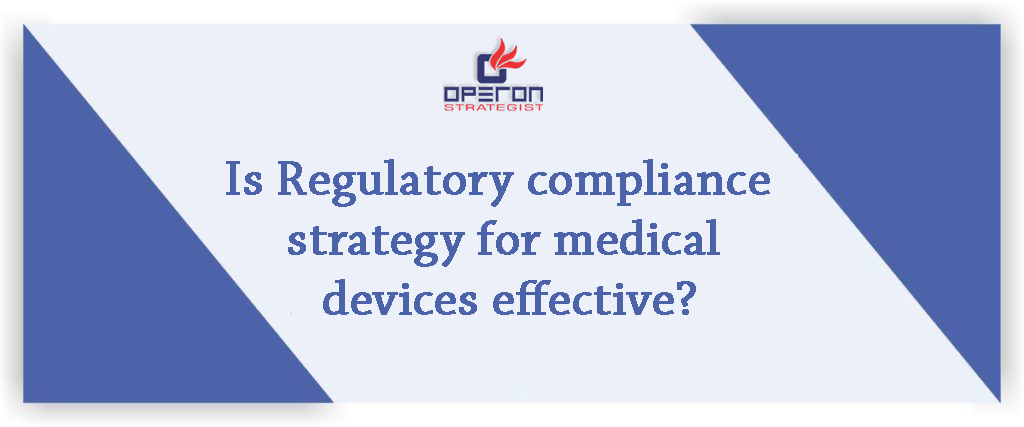Is Regulatory compliance strategy for medical devices effective?
A Regulatory Compliance Strategy for Medical Devices is a regularly formal report that adjusts the regulatory activities, together with the business strategy, to bring another or changed medical device to the market. It recognizes the significant regulatory elements to be addressed to and provide the general definition to the task.
Medical device manufacturers who consider the full scope of material regulatory issues at the soonest potential stages of product development can all the more successfully plan the dispatch of new products. With an effective regulatory strategy, existing issues with the medical device can be distinguished and redressed before, keeping away from conceivably costly and tedious restorative endeavours at a later.
Why is the regulatory compliance strategy for medical devices important?
Medical device manufactures that neglect to represent regulatory compliance issues from the get-go in the process is regularly met with unexpected surprises. Efforts to accomplish compliance with regulatory requirements after the product development process has been finished and can be a fundamentally progressively complex undertaking and can even reason further product development efforts with lengthy delays.
- Operon Strategist is US FDA 510 k process consultant helps the clients to register SBU (Small Business Unit), take out the testing requirement of the product, creation of the dossier, resolving the queries.
What can make the best regulatory compliance strategy for medical devices?
- Establishing a leadership team
- Conducting Gap Analysis
- Distributing Resources to support Compliance activity
- Developing a Regulatory Compliance Strategy for Medical Devices
- An effective regulatory compliance strategy for medical devices must contain a number of elements, including:
-
Establishing a leadership team
Good leadership is essential for managing with the change compliance and making an execution procedure which remembers courses of events and systems for the following advancement for compliance activities. At any rate, this leadership team ought to incorporate agents from Regulatory Affairs, Quality Assurance, Medical and additionally Clinical Affairs, Marketing, Manufacturing, Bio-compatibility, Sterilization, R&D, and Labeling. This leadership team group must be effectively occupied with speaking with the Notified Body, just as building up venture harmonization amongst speciality units and products portfolio
-
Conducting a gap analysis
One of the main questions for manufacturers to ask while directing a gap analysis is whether their current products are compliant. A gap assessment can assist manufacturers in figuring out which compliance procedure is generally suitable for them. At the very least, manufacturers ought to perform:
- Technical gap analysis
- Regulatory gap analysis
- Clinical gap analysis
As a gap analysis is specific to the manufacturer, the therapeutic area, and the product or family of products, each gap analysis is different. However, the aim of every gap analysis is the same: to identify areas of non-compliance and then remediate those to not only bring the product to compliance but also sustain that compliance.
- We are leading Medical Device CE Certification Consultant for medical device disposable implant manufacturers, medical disposable syringe manufacturers, surgical instrument manufacturers, and etc.
-
Distributing Resources to support Compliance activity
Work-related to compliance with the new regulation is an additional obligation, likely one with which manufacturers present workers have almost no experience. For manufacturers who do not have the fundamental ability, it is to their greatest advantage to spending plan for and procures the correct topic specialists who can bring the organization into MDR compliance and train workers to look after compliance.
-
Developing a Regulatory Compliance Strategy for Medical Devices
The expanding unpredictability of the worldwide medical device commercial centre legitimately converts into a more noteworthy weight on medical device manufacturers, particularly when looking for advertising access over different commercial centres. Since small and medium-sized entities include most of the organizations in the medical device industry, the effect on expenses and lead times can be huge. These organizations frequently need internal expertise to conduct statistical surveying or to explore the regulatory maze.
-
An effective regulatory compliance strategy for medical devices must contain a number of elements, including:
- Determining a cost/return on investment for anticipated market areas
- Perceived market demands
- Current competitive landscape
- Distribution methods
- Reimbursement strategies and policies
- Legal issues, including intellectual property protection
- Ability to leverage approvals gained in primary markets to extended markets
- Financial, professional and technical resources
In the global market places, regulatory changes can cause fines, penalties and loss for market access. But in some cases, Regulatory Compliance strategies for medical devices can also be a good decision. Changes to regulatory oversight will most probably alter the competitive landscape. Global players need a well-developed and well-implemented plan to turn this Regulatory compliance strategy for medical devices, requirements into a source of competitive advantage that will allow them to reap economic benefits. By embracing complexity, medical technology companies can seize opportunities to lead in the industry, effectively navigate new regulations, and disrupt through innovation.


